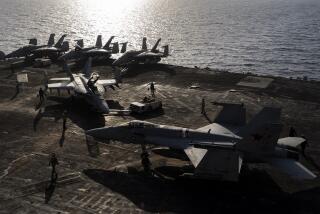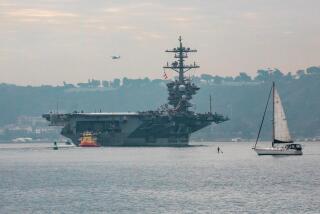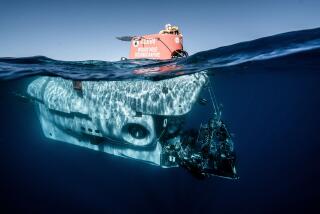‘Floating Shoe Box’ Gets Job Done
ABOARD THE BONHOMME RICHARD — Any amphibious assault the U.S. military makes on terrorist strongholds might well begin on a ship like this one training off Southern California.
Big, boxy and lacking the massive grandeur of an aircraft carrier or the sleek lines of a missile-equipped destroyer or frigate, the big-deck amphibious assault ships are the backbone of the military’s ability to bring combat troops, firepower and equipment ashore quickly virtually anywhere in the world.
“We get the job done, and we get the job done right,” said Petty Officer Felix Choice.
Commissioned in 1998, the 844-foot-long, 41,500-ton Bonhomme Richard, based in San Diego, carries 1,500 combat Marines, 30 to 35 CH-46 helicopters, five Harrier vertical-lift attack aircraft, three air-cushioned landing craft and enough trucks and armored vehicles to provide short-term support for Marines ashore.
Like other big-deck amphibious ships, the Bonhomme Richard is the command ship for a three-vessel squadron called an amphibious ready group.
“Everybody knows that when there’s trouble, the president asks, ‘Where are the carriers?’ ” said Capt. Stanley De Geus, the ship’s skipper. “Right after that he asks, ‘Where are the ready groups?’ ”
The Bonhomme Richard also has a 300-bed hospital, giving it more medical capability than any vessel except the Navy’s hospital ships.
Tuesday, Marines and sailors began an 18-day training mission to prepare for deployment somewhere in the eastern portion of the Pacific Ocean and beyond. Training includes helicopter and Harrier operations, fire drills, “mass-casualty” drills and a mock assault on the beach at Camp Pendleton.
One of the first things the crew was taught was what to do if the ship is attacked by biological, nuclear or chemical weapons, a continuing concern amid reports that terrorists are attempting to acquire such weapons.
Even before the ship had cleared San Diego Harbor, Capt. Rolf Yngve, the ship’s executive officer, had taken to the public address system to tell sailors and Marines about the scrubbing showers that would be set up on deck to decontaminate everyone before they are allowed below decks. A full drill will be staged later in the training.
Three ships similar to the Bonhomme Richard are already in or near the Middle East: the Bataan in the Mediterranean, the Pelelieu in the Indian Ocean and the Essex off Japan.
The big-deck ships--each of which costs more than $1 billion--have been used for humanitarian as well as military missions because of their cargo-hauling and medical capabilities.
The Bonhomme Richard is set to deploy in January, although the order could come sooner as President Bush assembles firepower and personnel. Yngve said the ship’s orders are to “get to the highest readiness state as soon as we can.”
If needed, the Bonhomme Richard and the two smaller ships in its group, the Pearl Harbor and the Ogden, could be in the Persian Gulf within 30 days. The Pearl Harbor and Ogden also carry Marines, including combat engineers, and heavy equipment that could be used to cut roads in rocky terrain.
There are questions the top brass will not answer, even though they invited the media aboard during the training mission.
Do the ready groups deploy with Navy SEALs, capable of covert operations? “We have a wide range of capabilities,” said Capt. Christopher Ames, commodore for the Bonhomme Richard amphibious ready group.
Would the group be able to land enough troops and gear near a landlocked country such as Afghanistan, 300 miles from the nearest ocean? “We have quite a reach,” he said.
Still, there is a sense aboard the Bonhomme Richard that the world seems to pay little attention to the amphibious assault ships.
“You turn on the Discovery Channel and you see carriers and submarines but nobody does anything on amphibious assault ships,” said Jonathan England, an electronics technician.
“We don’t get a lot of recognition,” said Jason James, also an electronics technician. “But even if people don’t know it, we’re out there doing the job, and that’s what’s important.”
Capt. De Geus concedes that the Bonhomme Richard and other ships of its class have been called floating shoe boxes, but he rejects the idea that they are not as attractive as the Navy’s better-known ships.
“I think she’s the most beautiful ship I’ve ever seen,” he said.
More to Read
Sign up for Essential California
The most important California stories and recommendations in your inbox every morning.
You may occasionally receive promotional content from the Los Angeles Times.










